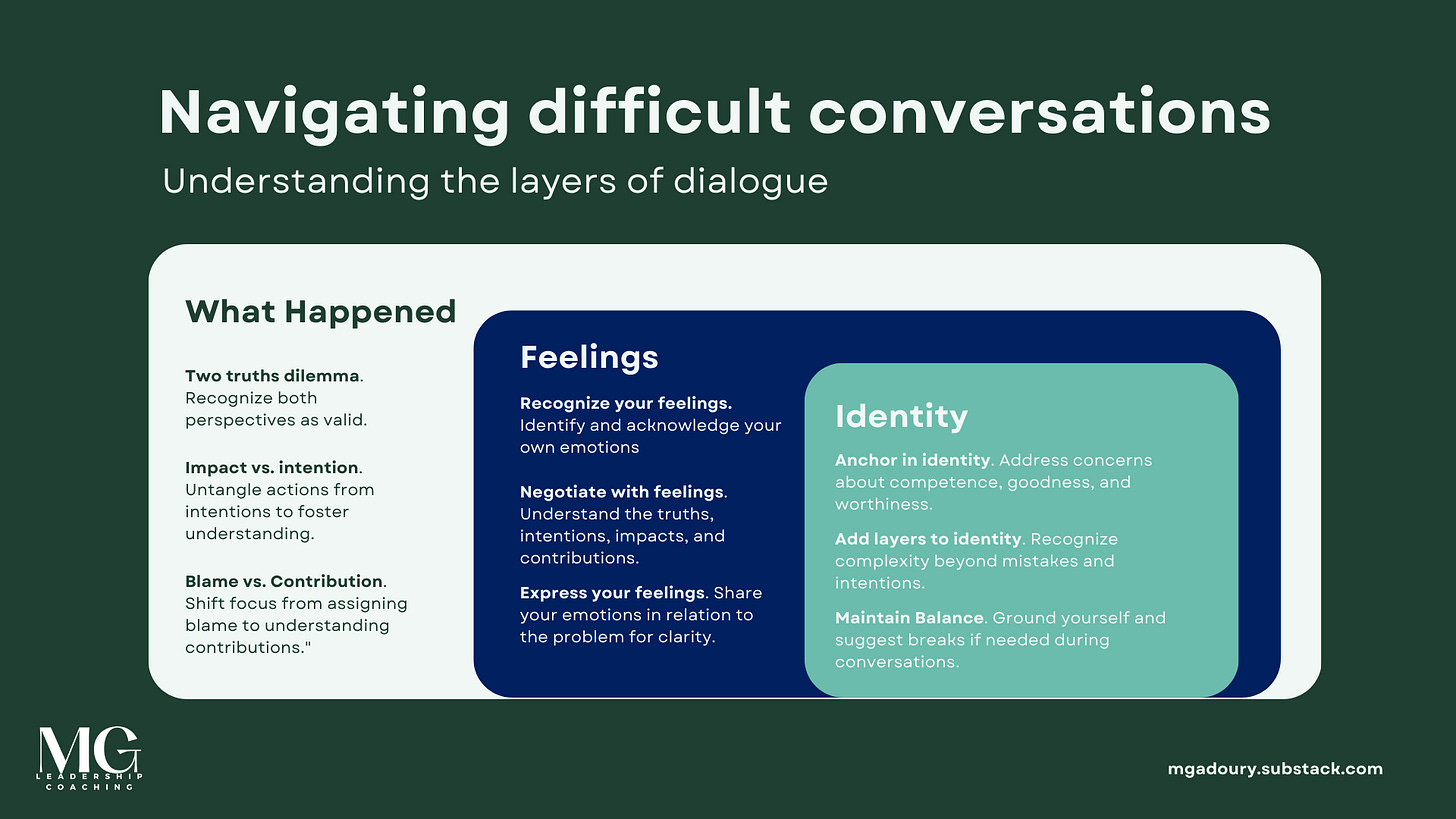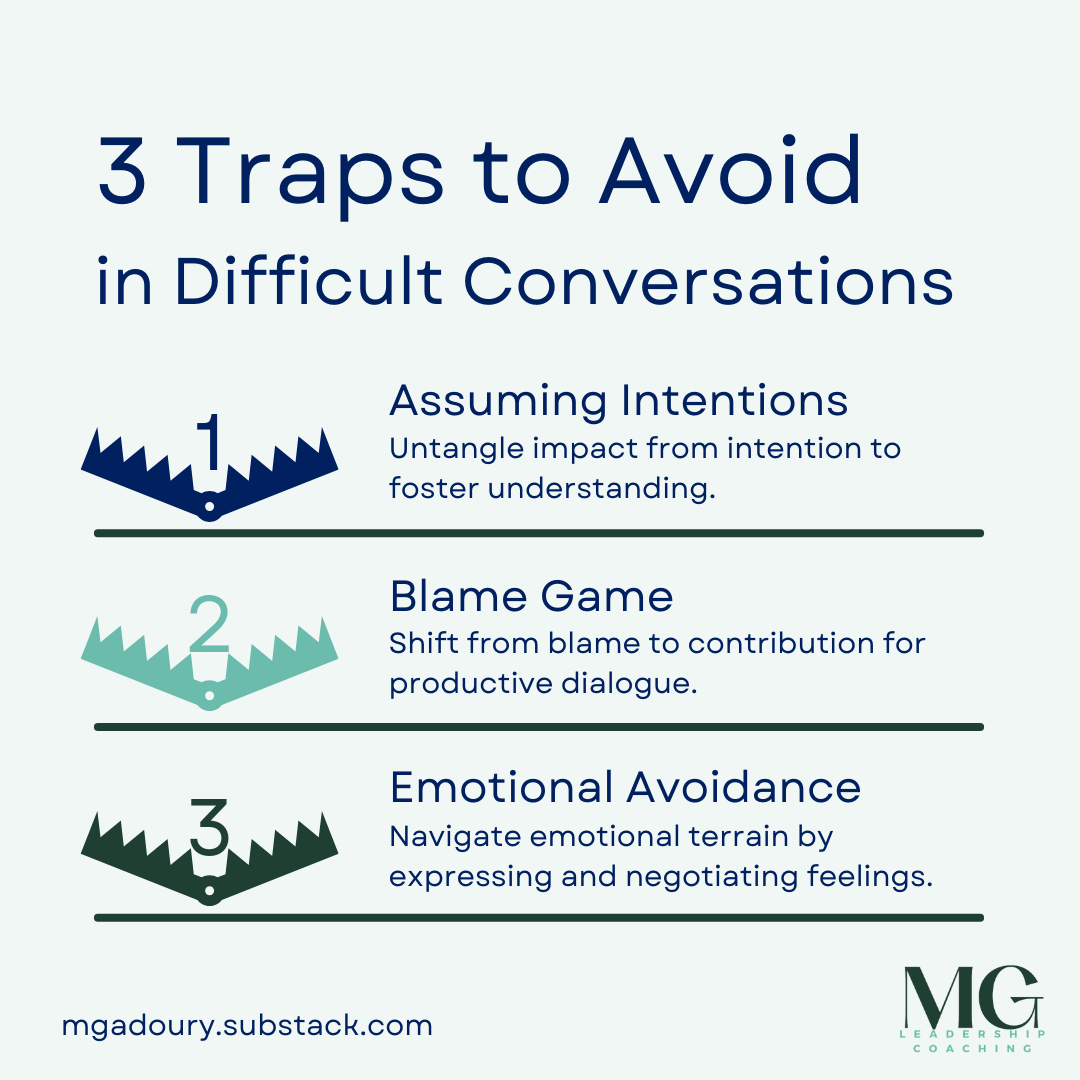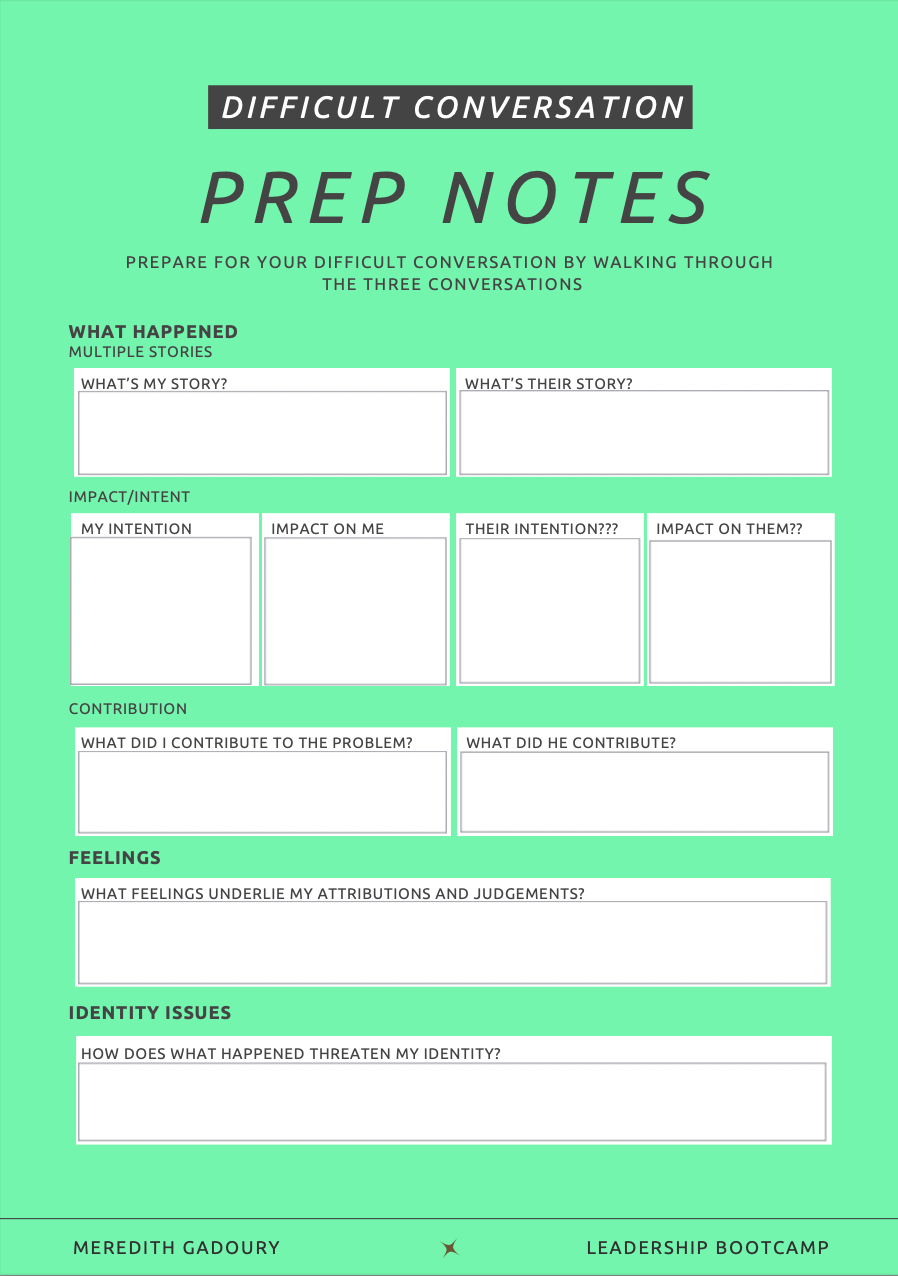Pre-Newsletter Heads-Up: In case you didn't catch last week's edition, I'm spicing things up for the next few newsletters with a four-part series delving deep into the art of handling difficult conversations. Last week, Part 1 covered the “whys” of difficult conversations and Part 2 is all about steering clear of conversation pitfalls. Brace yourself for Part 3, where I'll lay out a foolproof step-by-step process for your next challenging chat. Finally, Part 4 will be a "Top 10" rundown on handling difficult conversations. If this topic piques your interest, check out Difficult Conversations: How to Discuss What Matters Most for some valuable insights!
A quick recap
In my last newsletter, I dug into the intricacies of why difficult conversations are, well, difficult. It's not just one conversation; it's a triple-decker of discussions happening simultaneously:
The “what happened” conversation - Who said what? Who did what? Who’s right and who meant what? And of course, who’s to blame?
The feelings conversation - Are my feelings valid or appropriate? Should I acknowledge or deny them? And what about the other person's feelings – especially if they're angry or hurt?
The identity conversation - How might this impact my self-image, self-esteem, future, and overall well-being?
I dove into the complexity of these three conversations and how they intertwine, making conversations a tad more complicated than we'd like.
Now, let's circle back to those three chats and zero in on dodging the common traps we often stumble into during these tricky discussions.
The “what happened” conversation
The Truth
In part 1, I delved into the intricacies of the "truth" in any situation. Turns out, our version of "truth" often varies from someone else's. We make different observations, create different interpretations, and draw different conclusions from the same scenario. The result? We might feel like they're the issue, and vice versa. So, what do we do?
We can solve the two truths dilemma, by adopting the AND stance. Both stories can be “true” simultaneously for each person involved. It's not about proving one story right. It's about recognizing that both perspectives matter, along with each person's feelings. Both narratives hold weight.
You can feel hurt, angry or wronged AND they can feel the same.
Someone can be giving their best effort AND you might feel like they’re not working hard enough.
Understanding each other's stories lays the groundwork for shifting gears into problem-solving mode.
The Impact
We covered two key blunders for maximum impact:
Our assumptions about intentions are often off the mark.
Good intentions don’t magically erase bad impact
To tackle these slip-ups, let's first untangle impact from intention. Share how someone's actions affected you, but ditch the assumption game about their intentions. Instead of pretending you're assumption-free, face it head-on and get curious about what they actually intended. For example:
The story I’m telling myself is that you highlighted my mistake to make me feel worse and punish me. But I know that might not be true. What was your actual intention in bringing up the mistake?
Next up, be an avid listener for feelings and reflect on your own intentions. Just because you had good intentions, doesn’t excuse any negative impact. Dig deep beyond the accusations and understand how it made the other person feel. If it's not clear, don't hesitate to ask them! Also, keep in mind that your intentions might not be all squeaky clean – humans are intricate beings with a mix of both good and not-so-great intentions all at once!
The Blame
When blame comes knocking, resist the urge to play the finger-pointing game. Instead, set your sights on the concept of contribution – a forward-looking approach rooted in understanding. Unpacking how each person contributed to the problem fosters learning, change, and sets the stage for a smoother discussion.
Ask yourself
What did EACH of us do or not do that landed us in this mess?
Armed with this insight, how can we make changes?
What steps can we take as we move forward?
Struggling to pinpoint contributions? Step into the other person's shoes or view the problem from a third-party perspective. Remember, contribution isn't always a 50/50 split; it can vary. One person might contribute 98%, while another pitches in 2%. Still, there's room for a discussion on joint contributions.
To steer a conversation from blame to contribution, follow these steps:
Identify contributions: What did they contribute? What did you contribute? Who else is in the mix?
Own up to your contribution early on.
Help the other party grasp their contribution by spelling out your observations and clarifying what they could have done differently.
Only once you've shifted the conversation from blame to contribution can you dive into problem-solving and craft action steps to resolve the issue.
The feelings conversation
In part 1, I highlighted how unexpressed feelings tend to seep into conversations, both subtly and significantly, hindering our ability to truly listen. So, how do we navigate the emotional terrain in difficult discussions?
Step 1 is to get better in touch with your own feelings. Beyond the current conversation identify which feelings you're comfortable expressing and where you hold judgments. Instead of suppressing emotions, recognize them as natural reactions, especially in tough talks. Delve deep when reflecting on the discussion, uncovering the hidden layers beneath simple labels like good, bad, or anxious. If pinpointing your feelings proves challenging, look at any judgments or blame you may be harboring. For example, if you judge someone's work performance as inadequate, it might mask a fear that you didn't delegate the project effectively.
Once you've got a grip on your emotions, move to step 2: negotiate with your feelings. Identify the truths, intentions, impacts, and contributions by using the exercises listed above. After tackling the "what happened" conversation, reassess your feelings post-reflection.
For any lingering emotions after step 2, share them with the other person. The key is not just to vent but to describe your feelings in relation to the problem. A handy phrase to use is "I feel." For instance, in the above example of someone with inadequate work performance, you might say:
“I feel worried that this project isn’t going to be completed up to par. I fear that I didn’t give clear enough directions at the start when I asked you to complete these tasks.”
Remember in the realm of feelings, both parties can experience strong emotions simultaneously, and both sets of feelings are valid based on each other’s perceived "truths."
The identity conversation
When it comes to the identity conversation, just like with feelings, it's crucial to do some upfront internal work. To avoid falling prey to the all-or-nothing syndrome (check out part 1 for my breakdown), anchor yourself in your identity. Address your concerns around three identity questions:
Am I competent?
Am I a good person?
Am I loved (worthy)?
Next, add layers to your identity. Missing a work deadline doesn't strip away your competence. Having a less-than-stellar intention doesn't make you a bad person. People might not adore you, but that doesn't negate your worthiness of love. Remember these key points:
You will make mistakes. A lot of them.
Your intentions are complex. Not all of them are good.
You have contributed to the problem. Even if you think you haven’t.
Once your identity is on more solid ground, you'll maintain better balance throughout the conversation. Keep in mind that you can't control their response. If you sense yourself teetering during the talk, suggest a break and return when you feel more grounded.
Coaching Challenge
Consider an upcoming difficult conversation, whether personal or professional.
Use the worksheet below as your prep guide, navigating through the three conversations.
Stay tuned for next week's newsletter, where I'll share a step-by-step process to help you tackle your next difficult conversation.




